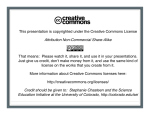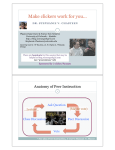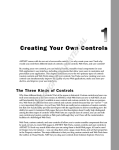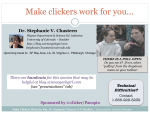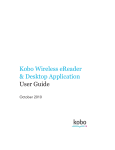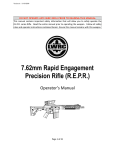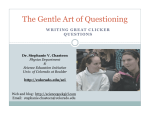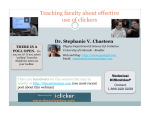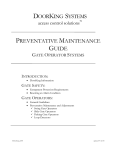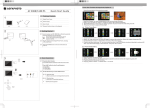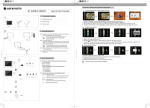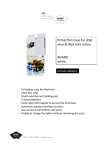Download Facilitating Clickers Effectively
Transcript
1/25/14 This presentation is copyrighted under the Creative Commons License! Attribution Non-Commercial Share-Alike! ! ! That means: Please watch it, share it, and use it in your presentations. Just give us credit, don’t make money from it, and use the same kind of license on the works that you create from it.! More information about Creative Commons licenses here: http://creativecommons.org/licenses/! Credit should be given to: Stephanie Chasteen and the Science Education Initiative at the University of Colorado, ! http://colorado.edu/sei! • ! Facilitating Clickers Effectively! Sponsored by i>clicker! Dr. Stephanie V. Chasteen Science Education Initiative University of Colorado – Boulder [email protected] Clicker resource page at http://STEMclickers.colorado.edu Handouts at http://blog.sciencegeekgirl.com There is a poll open Tell us if you’re having trouble finding it. Agenda: Brief intro -- Effective Questions -- Facilitation Matters Creative Commons – Attribution. Please attribute Stephanie Chasteen / Scince Education Initiative/ CU-Boulder 1 1/25/14 Peer Instruction and Clickers • • • • 3-5 questions per class Students discuss & vote Improved learning (multiple studies) Used by ~30% of physics faculty* * Dancy & Henderson, AJP, 2010 Intro 2 1/25/14 U. Colorado Clicker Website http://STEMclickers.colorado.edu Clicker resource page • Downloadable Instructor’s Guide • Question banks • Workshops • Literature / Articles • Short videos 5 Creative Commons – Attribution. Please attribute Stephanie Chasteen / Science Education Initiative/ CU-Boulder Clickers are a tool for questioning But not a magic bullet! Don’t equate the pedagogy with the technology. So what IS the pedagogy? 6 3 1/25/14 Why question? 1. Why do we ask students questions in class? 2. Why might we use clicker questions? Chat Discussion Think on your own, then share ideas in the chat. 7 Creative Commons – Attribution. Please attribute Stephanie Chasteen / Science Education Initiative/ CU-Boulder Clickers help students learn... the learning cycle BEFORE DURING AFTER setting up instruction developing knowledge assessing learning Adapted from Rosie Piller, Ian Beatty, Stephanie Chasteen 8 Peter Newbury, UCSD 4 1/25/14 Clickers help students learn... the learning cycle BEFORE DURING AFTER setting up instruction developing knowledge assessing learning Adapted from Rosie Piller, Ian Beatty, Stephanie Chasteen 9 Peter Newbury, UCSD Clickers help students learn... the learning cycle BEFORE DURING AFTER setting up instruction developing knowledge assessing learning Adapted from Rosie Piller, Ian Beatty, Stephanie Chasteen 10 Peter Newbury, UCSD 5 1/25/14 Clickers help students learn... the learning cycle BEFORE DURING AFTER setting up instruction developing knowledge assessing learning Adapted from Rosie Piller, Ian Beatty, Stephanie Chasteen 11 Peter Newbury, UCSD Clickers help teachers teach… Are they ready for the next topic? What do they already know? Do they care about this? What DO they care about, anyway? BEFORE DURING AFTER setting up instruction developing knowledge assessing learning Adapted from Rosie Piller, Ian Beatty, Stephanie Chasteen 12 Peter Newbury, UCSD 6 1/25/14 Clickers help teachers teach… Where are they in the activity? Are they getting it? Do I need to intervene? Did they notice key idea X? BEFORE DURING AFTER setting up instruction developing knowledge assessing learning Adapted from Rosie Piller, Ian Beatty, Stephanie Chasteen 13 Peter Newbury, UCSD Clickers help teachers teach… Did they get it? Can I move to the next topic? Did that activity work? How did I do? BEFORE DURING AFTER setting up instruction developing knowledge assessing learning Adapted from Rosie Piller, Ian Beatty, Stephanie Chasteen 14 Peter Newbury, UCSD 7 1/25/14 Anatomy of Peer Instruction Ask Question …Lecture… Debrief / Class Discussion (May vote individually) Peer Discussion Vote * See also: Peer Instruction, A User’s Manual. E. Mazur. 15 Clicker Choreography See handouts 8 1/25/14 Clicker choreography These are in your handouts 1. Present the question. Don’t read it aloud. 2. “Please answer this on your own.” 3. Give the students sufficient time to make a choice. “Do you need more time?” 4. “Please vote.” 5. Check distribution of votes privately. 6.Depending on the distribution of votes, proceed. 17 Clicker choreography These are in your handouts 6.Depending on the distribution of votes... Have students discuss with peers (usually) ate Have a class discussion Discuss question yourself M ore on sl thi r… 7. At the end, confirm the answer(s) and continue with the class. 18 9 1/25/14 Clickers help students learn (the research) Research shows that: • Courses using peer instruction outperform traditional lecture courses on a common test • Students can better answer a similar question after talking to their peers (especially difficult questions!) See http://STEMclickers.colorado.edu for various references What do we want? Evidence-based ! ! ! change.! When do we want it? After peer review! Clickers & Classroom Culture Research shows that students say that clickers: • Help them show up for class and participate • Make them feel part of the class community • Make their “voice” heard in class • Hold them accountable for learning • Increase group learning outside the classroom • But only if clickers are used well! 10 1/25/14 Part 1 Effective Questions Example Question: History In your opinion, which has had the most posi?ve impact on the modern world? A) coffee Good discussion/debate B) tea question, before or after instruction C) chocolate D) spice E) sugar 22 11 1/25/14 Example Question: Superpowers Which superpower would you rather have? The ability to… A. Change the mass of things B. Change the charge of things C. Change the magnetization of things D. Change the boiling point of things 23 No-one-rightanswer also works in the sciences Question: Ian Beatty, UMass-Amherst Image: Thibault fr on Wikimedia Example question: Astronomy You look to the eastern horizon as the Moon is rising and discover that it is in the new moon phase. Later that same day when the moon is setting, which of the moon phases shown below would the Moon have looked like? Helping with visual literacy and application of a concept to daily life. Center for Astronomy Education, Ed Prather 24 12 1/25/14 Example of a less effective question “Apprized” means A) Appreciated B) Compromised C) Defied D) Noted No need to talk to your neighbor; you know it or you don’t! Does not encourage reasoning. 25 Another example of a less effective question What causes the seasons? A) The change in the earth’s distance from the sun during the year B) The ?lt of the earth’s axis C) Changes in the sun’s brightness D) Changes in clouds E) None of the above Can pattern-match to find the answer because “tilt” would have been mentioned during lecture 26 13 1/25/14 Better seasons example What would happen to the seasons if the earth’s orbit around the sun was made a perfect circle (but nothing else changed) ? A. There would be no seasons B. The seasons would remain pretty much as they are today C. Winter to spring would differ much less than now D. Winter to spring would differ much more than now Much better question. Requires reasoning! 27 Let’s try it! A small acorn over time can grow into a huge oak tree. The tree can weigh many tons. Where does most of the mass come from as the tree grows? A) Minerals in the soil B) Organic matter in the soil C) Gases in the air D) Sunlight A Private Universe; Annenberg Media 28 14 1/25/14 Any burning questions? Ask Question …Lecture… (May vote individually Peer Discussion Debrief Vote 29 What makes a good clicker See handout question? clarity context connection to learning goals distractors difficulty Stimulates thoughtful discussion Students should waste no effort trying to figure out what’s being asked. Is this topic currently being covered in class? Does the question make students do the right thing to demonstrate they grasp the concept. Use tempting distractors. What do the “wrong” answers tell you about students’ thinking? Use a variety of difficulty levels. Is the question too trivial? too hard? Will the question engage the students and spark thoughtful discussions? Is there potential for you to be “agile”? 30 15 1/25/14 Various question types Mix up your question strategies to keep things fresh and help students practice different skills Conceptual “one right answer” Let’s try it! A small acorn over time can grow into a huge oak tree. The tree can weigh many tons. Where does most of the mass come from as the tree grows? A) Minerals in the soil B) Organic matter in the soil C) Gases in the air D) Sunlight A Private Universe; Annenberg Media 27 16 1/25/14 Discussion “no one right answer” How#much#do#you#personally#think#that# cultural#factors#explain#differences#in# evidence#of#violent#behaviors#between# men#and#women?# A. Not#much#at#all# B. A#liAle# C. They#are#someDmes#useful# D. They#explain#most#of#what#we#see# E. Don’t#know/#other# 15# Stefanie#Mollborn# Predict an outcome You’re on a cart, initially at rest, throwing balls at a partition that is rigidly mounted on the front of the cart. If the balls bounce straight back, as in the figure, then is the cart put in motion? A. B. C. D. Yes, left Yes, right No Don’t know Eric"Mazur,"“Peer"Instruc3on”" 5" 17 1/25/14 Survey questions Do#you#know#someone#who#has# cancer#(or#had#it#in#the#past)?# # A. Yes,#someone#close#to#me# B. Yes,#but#I#didn’t#know#them#well# C. No# D. Not#sure# Origin#unknown# 28# Beyond True/False: Embed reasoning in answers In#this#food#chain,#would# you#expect#to#have#more# owls#or#more#frogs?##Why?# 34# Cathy#Wanat,#Northampton#High#School# 18 1/25/14 Images as Choices John%is%walking%to%school.%This%graph% shows%his%posi3on%as%a%func3on%of% 3me.%When%is%John%moving%with%the% greatest%velocity?% posi3on% 3me% A% B% C% D% E% (UBC%CWSEI)% 12% Recap: question types 1. Conceptual “one right answer” questions 2. Discussion “no one right answer” questions 3. Predict an outcome (e.g., of experiment) 4. Survey questions / personal opinion 5. Embed reasoning in answers (“Slower, because gravity is acting against it.” “Slower, because it loses energy to friction.”) 6. Use images as answer choices See TEFA handout 19 1/25/14 Question-writing tips • DIFFICULTY: Don’t just use simple quiz questions; use questions at a variety of difficulty levels (see Bloom’s) • STRATEGIES: Use a variety of types of questions • TIMING: Use questions at a variety of points in lecture. • WORTHY OF DISCUSSION: Use interesting, challenging questions that prompt discussion and emphasize reasoning • DISTRACTORS: Use tempting distractors to challenge students’ ability to reason See handout Effective multiple-choice questions have believable “distracters.” 1) Talking with other instructors that have taught the course in the past. 2) Talking with your students one-on-one before class, after class, during office hours. 3) Using student responses to openended questions that you include in HW and exams. 4) Asking your students to come up with answers that will be used as the choices. 5) Use researched and documented student misconceptions. D. Duncan, Univ. of Colorado 40 20 1/25/14 But… The perfect question doesn’t solve all problems! Part 2 Facilitation Matters 21 1/25/14 Remember, not a magic bullet! Or, “the perfect question doesn’t solve all problems” Implementation is also important. 43 Student buy-in is key! Option 1: Explain why you are doing this Option 2: Demonstrate why you are doing this (better!) In your handouts is a link to some example “framing” activities: http://www.colorado.edu/sei/fac-resources/framing.html 22 1/25/14 The “Whiff of Credit” • May provide low-stakes incentive to have a good clicker score. • Give points for trying, and maybe a little more for getting a correct answer. • At the end of the semester, substitute the average clicker score for the worst homework score if it is better. • Have clear policies on cheating. Reacting to their votes) You don’t know what’s going to happen but you can an#cipate and prepare yourself for the likely outcomes. 46 After the individual vote (before peer discussion), you know the distribution & they don’t! You have lots of options. This is where you show your “agility.” 23 1/25/14 What do you think you should do with this first-‐vote distribu?on? (C is the correct answer) A) “Turn to your neighbors and convince them you’re right” B) Confirm correct answer and move on C) “Can someone who answered C tell us why they made that choice?” D) Other Discuss correct and incorrect choices 47 What do you think you should do with this first-‐vote distribu?on? A) “Turn to your neighbors and convince them you’re right” B) confirm correct answer and move on C) “Can someone who answered B tell us why they made that choice?” D) other 48 24 1/25/14 What do you think you should do with this first-‐ vote distribu?on? A) “Turn to your neighbors and convince them you’re right” B) confirm correct answer and move on C) “Can someone who answered B tell us why they made that choice?” (etc.) D) other 49 Chat Discussion! Peer Discussion: Challenges & Solutions? Best Practices:! • Create student buy-in! • Circulate ! • Use “good” questions! • Allow enough time (2-5 mins)! • Focus on reasoning in wrap-up! 50 25 1/25/14 Chat Discussion! Wrap-Up Discussion: Challenges & Solutions? Best Practices:! • Establish a safe, respectful environment! • Encourage sharing of ideas somehow! • Don’t necessarily show histogram immediately! • Ask multiple students to defend their answers! • Emphasize reasoning: Why wrong answers are 51 wrong and why right answer is right! What do you think you should do if this is the second-‐vote distribu?on? A) “Turn to your neighbors and convince them you’re right” B) confirm correct answer and move on C) “Can someone who answered B tell us why they made that choice?” (etc.) D) “Would someone like to explain why they picked the answer they did?” 52 E) other 26 1/25/14 Giving the answer stops student thinking! 53 What about content coverage? 27 1/25/14 Facilitation Matters (the research) Research shows that: • Peer discussion + instructor explanation of question works better than either one alone • Instructor explanation is particularly un-helpful for strong students. • Students prefer time for individual thinking & peer discussion. • Students prefer 2-5 challenging questions interspersed with lecture • High-stakes points have a negative effect on conversation quality See http://STEMclickers.colorado.edu for various references Action Plan • Take a few minutes to write down your action plan to implement ideas you heard about in this part of the workshop. • Email it to yourself! 56 28 1/25/14 Thank you! • Clickers resource page (videos, question banks, workshops): http://STEMclickers.colorado.edu • My web and blog: http//sciencegeekgirl.com • The Active Class blog: http://theactiveclass.com • Email: [email protected] Any burning questions? Ask Question …Lecture… (May vote individually Peer Discussion Debrief Vote 58 29





























